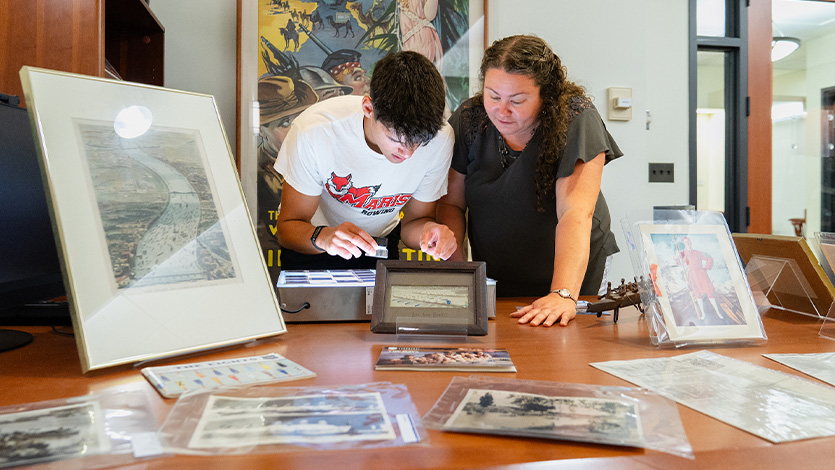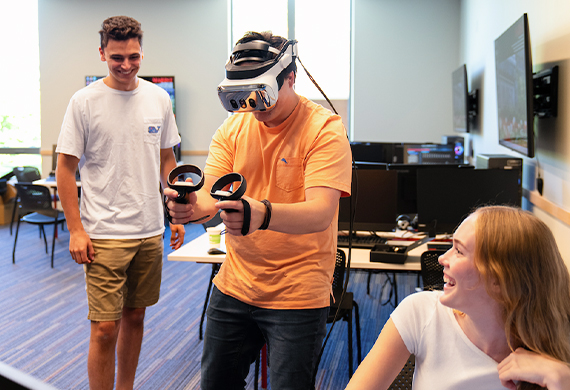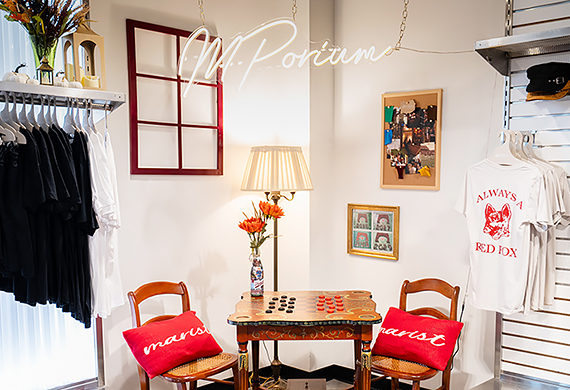World’s Largest Rowing Archive Finds a Home at Marist

Julius Stratton '28 and Elizabeth Clarke examine objects from Tom Weil’s rowing collection. Photo by Nelson Echeverria/Marist University.
September 16, 2025 — For over five decades, Thomas E. Weil Jr. pursued a passion that would eventually create the world's largest collection on rowing history. Today, that legacy has found its permanent home in the Archives and Special Collections at Marist, where it's inspiring a new generation of students and researchers to discover the rich history of the sport.
The collection consists of over 10,000 items, including more than 2,300 books, and tells the story of how rowing evolved over time, from a working person's necessity to transport food and cargo, into the competitive sport of today.
A Chance Connection
Tom Weil’s relationship with Marist began in 2021 after a chance inquiry regarding a now-shuttered rowing exhibit on display at the Mystic Seaport Museum in Connecticut.
“For years, we had been aware of the rowing exhibit at the Mystic museum, but we were never quite sure who was responsible for it,” said John Ansley, Director of Archives and Special Collections.
Curious as to what happened with the items in that exhibit, the archives staff made a call that led them to Tom and his friend Bill Miller.
An initial Zoom conversation led to an invite to Connecticut to view and discuss Tom’s collection, which was followed by a visit to Poughkeepsie. Marist's professional staff, facilities, and archive capabilities impressed Tom, and the University's existing Poughkeepsie Regatta Collection demonstrated a genuine commitment to rowing history.
"As Tom saw what we did with the Poughkeepsie Regatta, the website, the outreach, he understood that we know this, we want to help people, and that is what he wanted his collection to do," said Elizabeth Clarke, Coordinator of Library Instruction at Marist, who works in the archives.
Throughout Tom Weil’s life, he was passionate about rowing: from his time spent on the Yale crew to the decades-long accumulation of his extensive archive. Photos courtesy of Richard Weil and Susan Percival Weil.
Within just a few months, Weil was prepared to donate his collection to Marist.
The meaning of the donation deepened when Weil passed away in September, 2024 at the age of 75. His family and friends have since taken up the mantle of preserving his legacy, and have worked with the Marist archives to help transport his collection to the Poughkeepsie campus.
“Tom always said he wanted to share everything he could about the history of rowing with everyone,” said Richard Weil, Tom’s brother. “I believe, before he passed, he was able to achieve that vision in numerous ways with the help of so many others whom he would always acknowledge before himself.”
Building the World’s Largest Rowing Archive
A Yale rower from 1966-1970 and Vietnam War Navy veteran, Tom began collecting historical memorabilia and artifacts in the 1970s with a trip to London that would define the rest of his life.
Alongside his good friend Dave Vogel, another Yale rower, Tom planted the seeds of what would become the foundation for the world’s most comprehensive rowing archive.
“We started out going to every bookseller, every gallery, every small alley that we could find down in London,” said Vogel. “And we were just buying anything that had to do with rowing. Old newspaper articles, magazines, prints, anything we could get our hands on.”
“I had no idea at the time that this was going to be one of the greatest collections of rowing articles and memorabilia and artifacts ever assembled,” he said.
What makes the collection extraordinary isn't just its scope, but its meticulous curation.
Tom's approach to collecting was comprehensive, spanning from scholarly works on ancient rowing history to children's books featuring rowing themes, and from Olympic objects to mystery novels with rowing plots.
"He was very thorough in his collecting," said Ansley. "You might look at something and say, 'This is really not about rowing,' and then you look closer and notice, 'OK, there's one footnote about rowing.' But because it was from an important work, he wanted to get that particular article or book because it helped further the research."
The collection includes photographs, documents, trophies, artwork, T-shirts from crew meets spanning decades, and even beer bottles from Olympic commemorations.
“One might describe Tom as a hoarder with extremely well defined tastes,” Vogel said. "He was a very discerning collector and rowing was his passion."
John Ansley, Director of the Archives and Special Collections (center), works with Clark and Stratton on boxes of archival materials from Weil’s collection. Photo by Nelson Echeverria/Marist University.
Bridging Past and Present
Today, the collection is being processed by Marist’s archival team, which includes student worker Julius Stratton '28, a history and education major who rows for the Marist crew team.
For Julius, working on this archive represents an ideal intersection of his athletic and academic interests, exemplifying precisely what Tom had hoped to achieve.
"History is up my alley, rowing is up my alley," said Julius, who found out about the archives during a seminar for first-year students.
Julius comes from a family of rowers: his mother won the 1996 scholastic national championship, and his father was captain at Syracuse University. In fact, the archival work already yielded personal discoveries for Julius, as he has uncovered artifacts from both of his parents’ races.
Julius understands both the sport's demands and its deep sense of community. This reflects in his mentality in working with Tom’s archive.
"He's willing to jump into whatever we're working on," said Archives Assistant Ann Sandri. "Sometimes we have to pivot or change our plans for the work we're doing, and he is so enthusiastic about helping out in any way he can."
"It's not about me," said Julius. "It's about what Tom did and how he collected. I'm just a piece of the puzzle. I never met Tom, but I want to make him proud."
“We are very grateful that Tom’s collection has found a home at Marist and that it will be cared for as Tom would wish, especially by student archivists and rowers like Julius,” said Susan Weil Percival, Tom’s sister.
Realizing Tom Weil’s Vision
Plans for the Tom Weil Collection include comprehensive digitization, online finding aids, and educational programming. A major exhibit is planned for the 2026-2027 academic year, which will feature numerous display cases filled with highlights from the collection.
The project received a significant boost when Chris Seaver, Tom's Yale roommate, established a $100,000 endowment to support preservation and accessibility efforts. This funding ensures that Tom's vision of making rowing history available to researchers and enthusiasts worldwide will be fully realized.
"Tom was a real force of nature and just a lovely person," said Ansley. "I felt fortunate to get to know him, and it was really gratifying that he thought so highly of what we're doing here that he wanted to donate his collection to us."
As the processing work continues in the coming years, Tom's influence lives on through students like Julius.
“It's honestly really cool,” Julius said. “I never thought I'd be working with the biggest rowing archive in the world, so this is an opportunity and privilege that I do not take for granted.”



